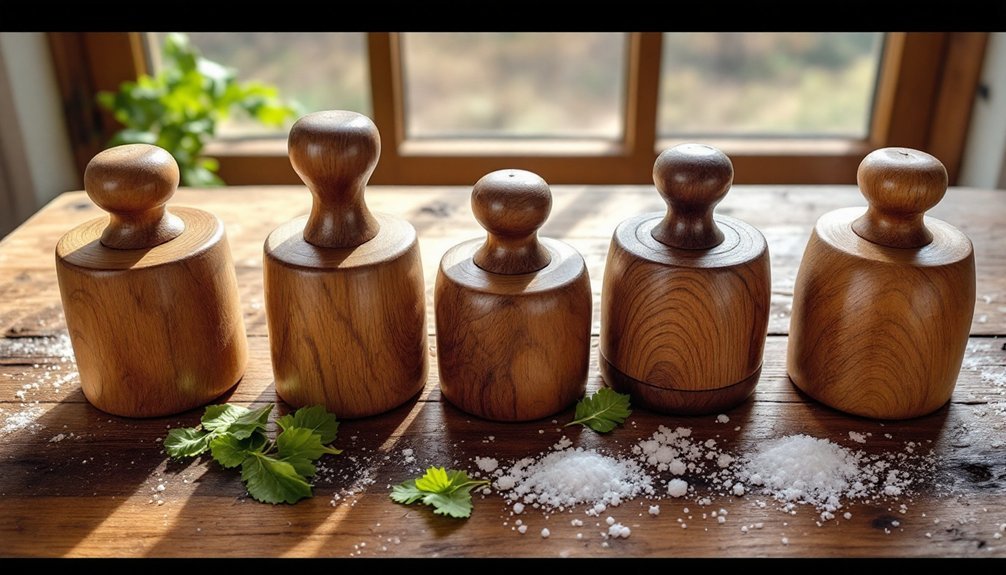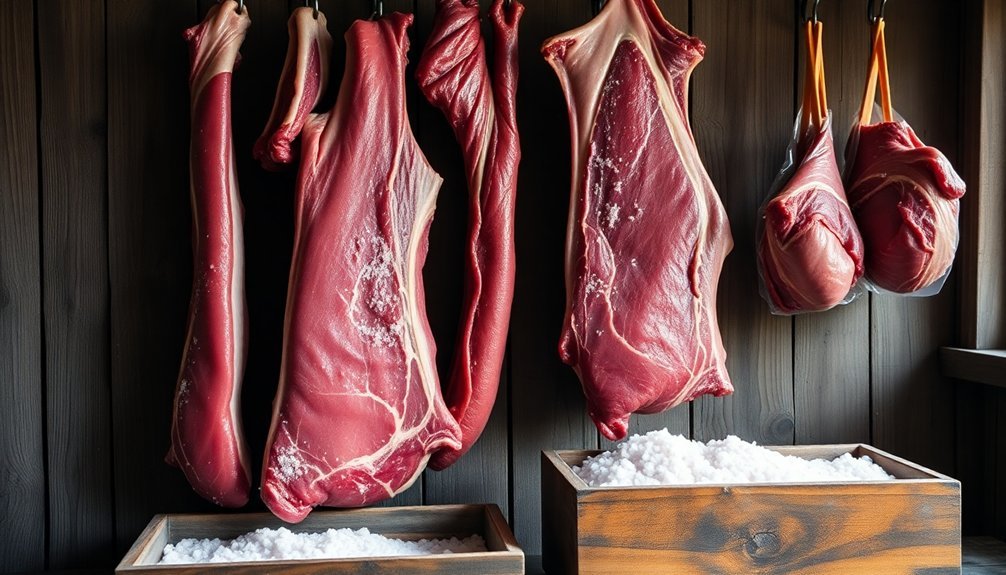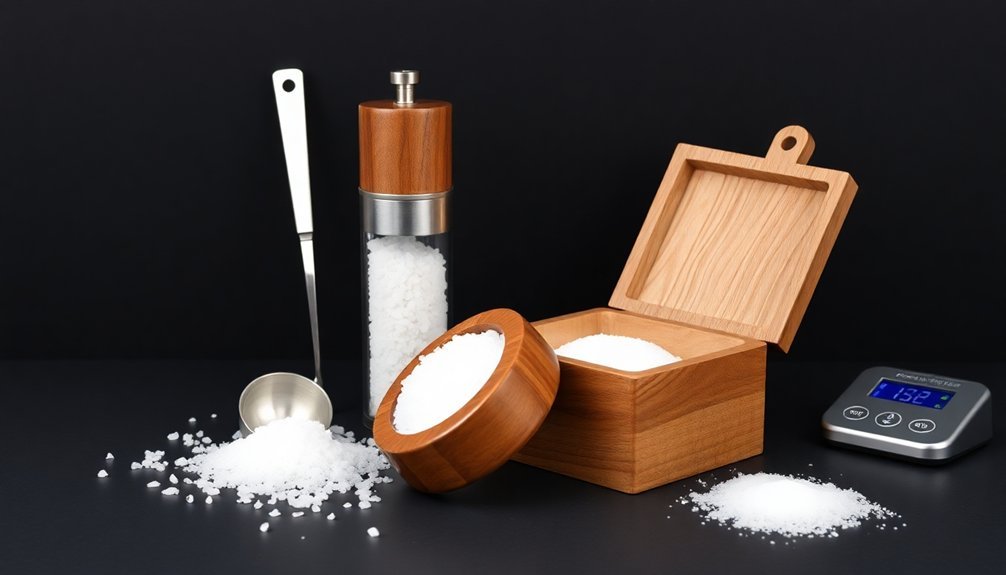You're about to discover how the right sauerkraut pounder can make or break your fermentation success. Whether you're a seasoned fermenter or just starting out, having the proper tool will transform your cabbage-crushing technique from tedious to effortless. We've tested dozens of pounders to bring you the top 7 picks for 2025, each offering unique features that'll help you create perfectly fermented foods. Let's explore these game-changing tools and find your perfect match.
Pickle Jar Fermentation Jar and Wood Sauerkraut Pounder
If you're looking to start fermenting foods for a small family, the Aosnttol Pickle Jar and Wood Sauerkraut Pounder set stands out with its versatile 2.5-liter capacity. The dual-ended beech wood pounder features 2.5-inch and 2-inch heads, making it compatible with both wide and regular mouth jars.
You'll appreciate the BPA-free jar's versatility for making everything from sauerkraut to kombucha. The leak-proof design and flip-top closure guarantee your ferments stay fresh, while the round shape makes it easy to pack vegetables. The non-toxic wood pounder resists cracking and splitting, perfect for tamping down cabbage, cucumbers, and other vegetables for your fermentation projects.
Best For: Home fermentation enthusiasts with small families of 2-5 people who want to make various fermented foods like sauerkraut, kimchi, and pickles.
Pros:
- Versatile dual-ended wooden pounder fits both wide and regular mouth jars
- BPA-free, leak-proof design with convenient flip-top closure
- Durable beech wood tamper resistant to cracking and splitting
Cons:
- Relatively low sales ranking suggests limited user feedback/reviews
- Hand wash only requirement adds to maintenance effort
- 2.5L capacity may be too small for bulk fermentation projects
Pickle Jar Fermentation Jar and Sauerkraut Pounder
Home fermenters seeking versatility will appreciate the Pickle Jar Fermentation Jar and Sauerkraut Pounder's dual-ended design. With 2.5-inch and 2-inch ends, you'll easily pack vegetables into both wide and regular mouth jars or crocks.
The fermentation jar's water seal creates an airtight environment that protects your pickles from contaminants, though you'll need to top off the water weekly. You can pound cabbage, cucumbers, and carrots effectively to extract juices for fermentation.
Maintenance is straightforward – just wash with regular detergent and store the dry jar in a moisture-free space. This combo offers everything you need for successful vegetable fermentation.
Best For: Home fermentation enthusiasts who want to make various pickled vegetables and need versatility in jar sizes.
Pros:
- Dual-ended tamper design works with both wide and regular mouth jars
- Water seal system creates reliable airtight environment for fermentation
- Easy to clean and maintain with standard kitchen detergent
Cons:
- Requires weekly water maintenance to maintain the seal
- Limited to vegetable fermentation specifically
- Must ensure complete dryness before storage to prevent issues
Pickle Jar Fermentation Jar and Sauerkraut Pounder
The Pickle Jar Fermentation Jar and Sauerkraut Pounder proves ideal for small households of 1-3 people with its compact 1.5-liter capacity. You'll appreciate its versatile design, featuring a dual-ended pounder that fits both wide-mouth (2.5 inches) and regular (2 inches) jars.
This BPA-free unit includes a ceramic lid with an airtight water seal that keeps unwanted odors, dust, and chemicals out of your ferments. You can use it for everything from sauerkraut and kimchi to jams and wine. Just remember to maintain the water seal weekly and hand wash the jar. While it's not dishwasher-safe, the simple maintenance routine helps preserve your fermentation projects effectively.
Best For: Home fermentation enthusiasts with small households who want a versatile, airtight system for making pickles, sauerkraut, kimchi, and other fermented foods.
Pros:
- Versatile dual-ended pounder fits both wide and regular mouth jars
- Airtight water seal system prevents contamination and unwanted odors
- Made from BPA-free materials with a ceramic lid for safe food preservation
Cons:
- Not dishwasher safe, requiring manual cleaning
- Weekly maintenance needed to maintain water seal
- Limited 1.5L capacity may be too small for larger households
Fermentation Pounder and Glass Weights for Mason Jars
Serious fermenters seeking reliable Mason jar tools will appreciate Brewing America's Fermentation Pounder and Glass Weights combo. This set, designed specifically for wide-mouth Mason jars, hit the market in February 2023 and has already earned perfect 5-star ratings from early adopters.
While it's currently ranked #330 in the brewing and fermentation category, don't let that number fool you. It's engineered for durability and practicality, making it a solid choice for your fermentation projects. You'll find the combination of a sturdy pounder with glass weights particularly useful for keeping your vegetables properly submerged during the fermentation process.
Best For: Home fermentation enthusiasts who use wide-mouth Mason jars and need reliable tools for properly weighing down and packing vegetables.
Pros:
- Perfect 5-star rating from early customers suggests high satisfaction with product quality
- Dual functionality with both a pounder and glass weights included in one set
- Specifically designed to fit wide-mouth Mason jars, ensuring proper compatibility
Cons:
- Relatively new product with limited customer feedback (only 4 ratings)
- Lower sales ranking (#258,253 in Kitchen & Dining) suggests limited market presence
- Warranty details not readily available and require additional inquiry
Kilner Fermentation Packer Tool for Sauerkraut & Kimchi
Fermentation enthusiasts seeking a professional-grade pounder will appreciate the Kilner Fermentation Packer Tool's thoughtful design. This FSC-certified beech wood tamper features a textured mashing head that effectively breaks down vegetables while eliminating pesky air bubbles.
At 24.5 cm long, you'll have plenty of reach for deep fermentation vessels, and it's perfectly sized to fit Kilner's 3L and 5L sets. The tool's impressive 4.7-star rating confirms its effectiveness for both sauerkraut and kimchi preparation. Just remember to hand wash it and avoid soaking to maintain its quality. You'll find it's a reliable companion for your fermentation projects.
Best For: Home fermentation enthusiasts and DIY food crafters who regularly make sauerkraut, kimchi, and other fermented vegetables and want a professional-grade wooden packing tool.
Pros:
- Made from high-quality FSC-certified beech wood with a textured mashing head for effective vegetable breakdown
- Generous 24.5cm length provides excellent reach for deep fermentation vessels
- Compatible with multiple jar sizes and highly rated by users with 4.7/5 stars
Cons:
- Requires hand washing and can't be soaked in water, making maintenance more demanding
- Limited to one specific function (fermentation packing) unlike multi-purpose kitchen tools
- Premium price point compared to basic wooden tampers or manual packing methods
Fermentation Tool Kit with Vegetable Pounder and Glass Weights
Crafted for home fermentation enthusiasts, this extensive tool kit equips you with everything needed to create perfect sauerkraut and other fermented vegetables. The set features an acacia wood pounder that fits both regular and wide-mouth mason jars, making it versatile for all your fermentation projects.
You'll love the heavy-duty glass weights that keep your vegetables securely submerged in brine, while the patented fermentation lid with airlock guarantees proper gas release. What's particularly clever is the lid's dual functionality – after fermentation, you can use it as a regular drinking lid with a pour spout. It's a thoughtfully designed kit that'll streamline your fermentation process from start to finish.
Best For: Home fermentation enthusiasts and DIY food crafters who want a complete kit for fermenting vegetables in mason jars, particularly those new to fermentation who need proper tools for consistent results.
Pros:
- Complete all-in-one kit with essential fermentation tools (pounder, weights, and airlock lid)
- Versatile acacia wood pounder works with both regular and wide-mouth mason jars
- Multi-functional lid design that transitions from fermentation to storage or drinking use
Cons:
- Relatively low sales ranking suggests limited market presence or customer feedback
- Limited to wide-mouth mason jar compatibility for some components
- Recently released product (April 2023) with unproven long-term durability
Fermentation Kit with Glass Weights and Airlock Lid
Small-batch fermenters will appreciate this extensive American-made kit that includes everything needed for successful vegetable fermentation. You'll get a 32oz wide-mouth Mason jar, a hefty vegetable pounder, four glass weights, and a patented Brewing America lid with an airlock system.
The heavy-duty pounder makes quick work of cabbages and other veggies, while the solid glass weights keep your vegetables safely submerged in brine. The durable fermentation lid features a bung and 3-piece airlock for secure fermentation. When you're done fermenting, you can repurpose the Mason jar for storage or use the pour-friendly lid for serving.
Best For: Small-batch home fermenters and DIY enthusiasts looking for a complete American-made starter kit for vegetable fermentation projects.
Pros:
- Complete all-in-one kit with quality components including glass weights and airlock system
- Versatile Mason jar can be repurposed for storage or serving after fermentation
- Heavy-duty pounder and weights make vegetable preparation and submersion easy
Cons:
- Relatively low sales ranking suggests limited market presence or customer adoption
- Single 32oz jar size may be too small for larger batch fermentation needs
- Premium price point compared to basic Mason jars without specialized accessories
Factors to Consider When Choosing a Stainless Steel Sauerkraut Pounder for Proper Fermentation
When you're selecting a stainless steel sauerkraut pounder, you'll want to check its material grade and construction quality to guarantee it's durable enough for repeated pounding sessions. The pounder's size, weight, and handle design should feel comfortable in your grip while being compatible with your fermentation jars' dimensions. Look for food-grade certification and 304 or 316 stainless steel options that won't corrode or leach harmful substances into your ferments.
Material Quality and Durability
Since the longevity of your fermentation tools directly impacts their performance, choosing a sauerkraut pounder made from high-quality stainless steel is essential. You'll want to look for 304 or 316-grade stainless steel, which offers superior resistance to rust and corrosion while maintaining structural integrity during repeated use.
The non-porous nature of stainless steel makes your pounder easy to clean and sanitize, preventing unwanted bacterial growth that could compromise your ferments. When you're working with acidic foods like sauerkraut and kimchi, you'll appreciate how the material stands up to harsh environments. The inherent weight of stainless steel also works to your advantage, helping you achieve proper compression with less effort. Your pounder won't bend or break under pressure, ensuring consistent results batch after batch.
Size and Weight Specifications
Selecting the right size and weight for your sauerkraut pounder makes a significant difference in fermentation success. You'll want to choose a pounder that weighs between 1-2 pounds, providing ideal leverage for packing vegetables firmly into your fermentation vessel.
Look for a pounder that's 12-15 inches in length, which allows you to reach deep into jars while maintaining comfortable control. The base should measure 3-4 inches in diameter to create an efficient compacting surface. When shopping, you'll need to verify your pounder fits standard jar sizes and fermentation crocks you're planning to use.
Don't forget to test the grip comfort – you'll be using this tool repeatedly, so an ergonomic design that fits your hand well is vital for preventing fatigue during extended fermentation sessions.
Handle Design and Grip
The handle design of your sauerkraut pounder can make or break your fermentation experience. You'll want an ergonomic grip that keeps your hands comfortable during extended pounding sessions, preventing fatigue while you work through batches of vegetables.
Look for a textured or contoured handle that won't slip when your hands get wet from the fermentation process. A longer handle offers better leverage, letting you pack vegetables with less effort. When testing pounders, you'll notice that well-balanced designs give you more control over the pressure you're applying.
The best handles feature non-slip materials that resist moisture while maintaining their grip quality. This combination of thoughtful design elements guarantees you'll get consistent results as you pack your ferments into jars.
Jar Compatibility Range
Beyond comfortable handling, your sauerkraut pounder needs to work seamlessly with different jar sizes. When choosing your fermentation tool, look for a design that's compatible with both wide-mouth and regular mason jars to maximize versatility in your kitchen.
A tapered end is essential for your pounder, as it'll help you reach the bottom corners of any jar shape, guaranteeing thorough vegetable packing. You'll want a pounder that can adapt to various jar capacities since different fermentation projects may require larger or smaller containers. For the best results, select a pounder that's specifically sized to work with your existing jar collection while maintaining enough reach to pack vegetables effectively. Remember to verify that your chosen pounder is made from food-grade stainless steel to prevent rust and guarantee long-lasting performance.
Food Safety Certification
When choosing a sauerkraut pounder, you'll need to verify its food safety certifications to confirm safe fermentation practices. Look specifically for FDA approval or NSF certification, which validates the product has passed rigorous safety testing for food contact use.
The best sauerkraut pounders are made from food-grade stainless steel, particularly grades 304 or 316. These materials resist corrosion and won't react with acidic ferments. You'll want to check that the certification labels demonstrate testing for harmful substances like lead, cadmium, and other heavy metals.
Don't overlook the importance of these certifications, as they ascertain the materials used in manufacturing meet strict health standards. This attention to safety prevents contaminants from leaching into your fermented foods and supports healthier home preservation methods.
Cleaning and Maintenance
Maintaining your stainless steel sauerkraut pounder's longevity requires proper cleaning and storage practices. After each use, hand wash your pounder with warm, soapy water, and avoid tossing it in the dishwasher as this can damage the tool. Don't use abrasive cleaners or rough scrubbers that might scratch the surface.
Once you've cleaned your pounder, it's essential to dry it thoroughly before storing. Any lingering moisture can lead to rust and corrosion, which will compromise your tool's effectiveness. Confirm you're storing it in a dry location to protect it from unnecessary moisture exposure. You'll also want to regularly check your pounder for signs of wear or damage to make certain it's still safe and effective for your fermentation projects.
Surface Texture Features
The surface texture of your stainless steel sauerkraut pounder can make a significant difference in your fermentation success. You'll want a surface that's smooth enough to prevent food from sticking but maintains enough texture to effectively grip and break down your vegetables. This balance guarantees ideal juice extraction from cabbage and carrots during the pounding process.
Look for pounders with either a brushed or polished finish, as these surfaces offer the perfect combination of durability and easy cleaning while resisting corrosion. The texture should also support even pressure distribution when you're packing vegetables, leading to uniform fermentation. Many quality pounders feature ergonomic grips that work in harmony with the surface texture, giving you better control and comfort during the packing process.
Storage Space Requirements
Smart storage planning plays an essential role in selecting your ideal sauerkraut pounder. Before making your purchase, measure the available space in your kitchen cabinets or drawers where you'll store both the pounder and fermentation equipment. You'll want to guarantee there's enough room for your complete fermentation setup without cramping your kitchen storage.
If you're working with limited space, look for a pounder that's compact or can be disassembled. This is especially important if you'll be fermenting frequently and need quick access to your tools. Consider how the pounder's dimensions align with your fermentation jars and other accessories. A well-thought-out storage solution will help you maintain an organized workspace and make your fermentation projects more enjoyable.
Frequently Asked Questions
How Much Force Should I Apply When Pounding Sauerkraut?
You'll want to pound your cabbage firmly but not aggressively – enough to release juices without pulverizing it. Apply consistent, moderate force until you see liquid pooling. Think firm taps rather than aggressive smashing.
Can I Use My Sauerkraut Pounder for Other Fermented Vegetables?
Yes, you can use your kraut pounder for any fermented vegetables that need compression. It'll work great for kimchi, pickles, and other ferments where you're trying to release moisture and remove air pockets.
How Do I Clean and Sanitize My Pounder Between Fermentation Batches?
You'll need to wash your pounder with hot, soapy water and rinse thoroughly. For extra safety, sanitize it with white vinegar or a food-grade sanitizer, then let it air dry completely before using again.
Why Does My Wooden Pounder Float During the Fermentation Process?
Your wooden pounder floats because it's less dense than the brine solution. To prevent floating, you'll need to use weights or fermentation weights to keep your vegetables submerged during the fermentation process.
How Long Should I Pound the Cabbage Before Adding Salt?
You don't need to pound the cabbage before adding salt. Instead, mix the salt with your shredded cabbage first, then pound for 5-10 minutes until you've released enough liquid to create brine.
In Summary
Now you're ready to choose the perfect sauerkraut pounder for your fermentation journey. Whether you've selected a traditional wooden tamper or a modern stainless steel design, you'll be well-equipped to create delicious, probiotic-rich ferments. Remember to take into account your jar sizes, material preferences, and frequency of use when making your choice. Start pounding, and you'll be enjoying homemade sauerkraut and kimchi in no time.





Leave a Reply